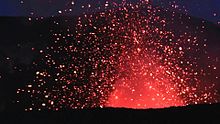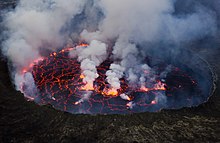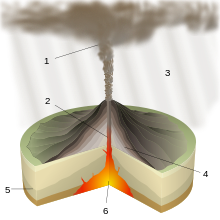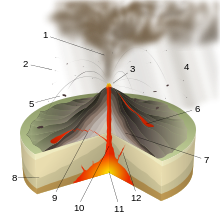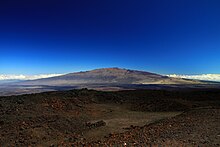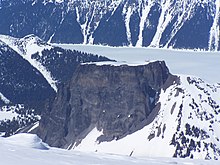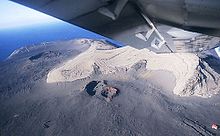Volcanic eruption
The volcanic eruption ( eruption ) is the best known form of volcanism . The magma chamber (s) of a volcano empty in a more or less destructive way or magma rises more or less directly from the earth's mantle through cracks and fractures .
The reason for this phenomenon lies at a depth around 100 km below the earth's surface, where temperatures of 1000 to 1300 ° C prevail. The melting rock expands, creating magma chambers. The resulting gases increase the pressure within the liquid mass over time; the magma rises. If the pressure exceeds a critical point, a volcano erupts.
Eruptions, for example in the case of shield volcanoes , can also be interrupted by periods of rest and divided into individual eruption phases; they can drag on for months and decades - cf. Kilauea - but are characterized by a common feature that distinguishes them from the next eruption: the very special chemical fingerprint, which can be proven by a precise chemical laboratory analysis of the ejected products, and which refers to a very specific, temporally and spatially limited source of magma.
According to geologist Elizabeth Cottrell of the Smithsonian Institution's volcano monitoring program, an average of about 70 volcanoes erupt on the earth's surface each year. At any given moment, there are 20 to 30 eruptions going on. This does not include the vast majority of the still unknown volcanoes on the ocean floor.
Types of volcanic eruptions
Different eruption products: explosive versus effusive eruptions
Explosive eruptions
Explosive eruptions primarily produce tephra .
They can generally be triggered either by overheating of groundwater and / or seawater above the magma chamber of the volcano ( phreatic or phreatomagmatic eruptions ) or by special chemical composition of magmas. Such eruptions can suddenly blow up rock masses that are cubic kilometers in size. The larger volcanic eruptions under glaciers also belong to this category (see subglacial volcano ).
When the magma chamber collapses during very explosive eruptions, a characteristically shaped wide crater is created, the caldera , for example in 1875 in Askja , East Iceland. If the caldera is flooded, a crater lake forms, in this case, for example, Lake Öskjuvatn . The devastating Krakatau eruption in Indonesia in 1883 was another such explosive eruption. The remains of the caldera are now arranged as four small islands in or around this crater lagoon and are located in the Sunda Strait between the Indonesian islands of Sumatra and Java . Such eruptions can also cause tidal waves and tsunamis that affect thousands of kilometers.
If the volcanic building collapses completely or partially during such eruptions, hot clouds of embers and ash or even pyroclastic currents can move down the slope like an avalanche at great speed, dragging everything along and burying it under them. The notorious eruptions of Mount Vesuvius in 79 and Mt. Pelé in 1902 fall under this category. Thousands of people were surprised and killed by pyroclastic currents in a very short time .
Another phenomenon of explosive volcanism are the lahars , which can form a stream of mud that is several meters high over many kilometers and can roll at speeds of up to 100 km / h. For example, the city of Armero in Colombia fell victim to such currents in 1985.
In general, the stratovolcanoes of the Pacific Ring of Fire in particular tend to behave in this way, as observed in 1980 on Mount St. Helens or in 1991 on Pinatubo .
Effusive eruptions
The effusive outbreaks, on the other hand, produce mainly liquid and semi-liquid lavas . During these processes, the magma is not so strongly permeated with - explosive - gases, it is much hotter and more liquid.
Fissure volcanoes and shield volcanoes in particular are prone to eruptions that have dragged on for several hundred years in the past (especially in the warm periods of the Ice Age ), with a very gently rising volcanic cone slowly building up.
A typical example of a shield volcano would be the Skjaldbreiður in Iceland . Such eruptions can still be observed today on the volcanoes on Hawaii or La Réunion, for example at Piton de la Fournaise .
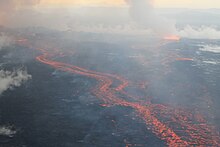
Examples of fissure eruptions in Iceland were the Laki crater in the years 1783–1784 or the one on the central volcano Krafla 1975–1984. In the meantime, however, it has been seen in recent studies and experience that such mixed or effusive eruptions can also release volcanic gases in considerable and harmful quantities. This was particularly evident from research on the gas release of the above. Laki eruption as well as the eruption in the rift system of Bárðarbunga 2014–2015.
Liquid lava can also accumulate in a depression or crater as a lava lake .
Types of eruptions by location and mechanism
Plinian eruption
The Plinian Eruption takes its name from the writer Pliny the Younger , who described the eruption of Vesuvius in 79 AD.
These are extraordinarily explosive eruptions, which are associated with enormous ash falls . The eruption of Vesuvius observed by Pliny, which can be assigned to this type of eruption, destroyed the cities of Pompeii and Herculaneum .
During such eruptions, a few cubic kilometers of magma can rise through the volcanic vents within a few hours . The tremendous pressure and the vehemently escaping gases push old remains of the plug upwards, with glowing scraps of lava and boulders being carried away from the crater wall . The flow of material rushes up the chimney at a speed of several hundred meters per second and forms an eruption column above the crater that extends into the stratosphere . If the cloud of dust and ash collapses, it forms the starting point for a pyroclastic flow . The collapse crater that remains is called the caldera .
The eruption of the Hekla volcano in Iceland in 1104 also belonged to this type of eruption. Further examples are the eruption of Mount St. Helens in 1980, that of Pinatubo in 1991 and that of the Laacher See volcano.
Pelean eruption
This type of eruption is named after the eruption behavior of the Montagne Pelée volcano in Martinique .
This type of volcanic eruption is characterized by a very high viscosity of the rising magma. This can often harden during the ascent and close the main chimney in the form of a plug for subsequent outbreaks. As a result, the volcanic fluids and gases look for side vents and cracks in the rock and often break under high pressure laterally in the form of glowing clouds through the slopes of the mountain. These pelée dynamics belong to the group of dynamics bound to gases (in contrast to dynamics bound to water) and can also have the effect that thick lava is deposited immediately as soon as it reaches the earth's surface and forms semi-stable lava domes at the exit points . When these collapse, pyroclastic currents form on the mountain slopes .
Vulcanian eruption
The Vulcanian Eruption is named after the volcanic island of Vulcano , one of the Aeolian Islands off Italy.
The eruption pattern consists of short, cannon-shot explosions (with corresponding shock waves ) that can occur individually or in series for up to a few hours. The strength of the eruption lies at the intersection between a Strombolian and a Plinian eruption .
In the main, highly fragmented volcanic ash is produced, which can rise up to 20 km in an eruption column. In addition, volcanic bombs are often ejected, which can fall within a radius of up to 5 km. Highly viscous magma of andesitic to dacitic composition is typical .
Various processes were identified as the cause: a) a sudden release of pressure from gas-rich, highly viscous magma in the near-surface production vent and b) a spontaneous release of gas accumulations from a magma chamber in the upper to middle earth crust.
Volcanoes that show volcanic eruptions are e.g. B. the Ngauruhoe in New Zealand, Galeras in Colombia and Soufrière Hills on Montserrat.
Strombolian eruption
The name Strombolian eruption refers to the Stromboli volcano , which is located on another of the Aeolian Islands in southern Italy.
Stromboli is constantly active, which is why it was called the lighthouse of the Mediterranean in ancient times. At irregular intervals (a few minutes to every hour) there are larger and smaller eruptions at several crater openings. The ejected material usually falls back into the crater or it partially rolls over the Sciara del Fuoco into the sea.
This regular ejection of lava scraps, cinder and ash is so typical of Stromboli that the term Strombolian or Strombolian activity is generally used for volcanic activity of this type. This continuous activity is due to the so-called two-phase convection . At a certain height of the chimney, the vapor pressure of the gases is greater than the pressure of the liquid above the gases. The gas bubbles formed as a result rise and, when they burst, tear fragments of magma with them on the surface. This outgassing brings about an increase in the density of the melt concerned, which in turn now drops and thus represents a continuous cycle.
Hawaiian eruption
The Hawaiian eruption describes the eruptions of shield volcanoes that can currently only be observed on the Hawaiian archipelago in the Pacific.
The Hawaiian volcanoes look like upturned shields, which explains the name shield volcano.
The cause of the typical shape is the outflow of very thin and therefore fast flowing, low-gas lava . This is usually of a basaltic composition and usually contains less than 52% silicon dioxide (SiO 2 ). When it exits, it is approx. 1000 ° C to 1250 ° C. The place of origin of the extracted magma is the upper mantle .
When it emerges, lava fountains up to 500 m high form on Hawaii .
The angle of repose of shield volcanoes be due to the high flow rate of the lava (up to 60 km / h) only about 5 °, that is, there These are all very gently sloping, but extended cone.
These lavas usually emerge over years, decades, sometimes even centuries through the same crater openings and thus build up the flat volcanic shields. For example, there are numerous shield volcanoes in Iceland, such as the Skjaldbreiður , which have a bottom diameter of several kilometers and were formed in interglacials or directly after the end of the ice age.
Phreatic eruption
Phreatic bursts are water vapor explosions in which superheated external water is converted into steam as a result of a sudden release of pressure. The resulting water vapor has about 1000 times the volume of water and bursts a crater into the ground. The rock that was previously in the crater is shattered. The ejected rock is deposited as a wall around the crater. Phreatic eruptions contain only broken "old" rock, no juvenile rock (ie pyroclasts see str.).
A phreatic explosion occurs when either external water comes close to the magma as a result of its flow or seepage movement (but has no direct contact!) And is strongly heated, or gases rising from the depths overheat the water above the boiling point. If the overlying rock cracks due to decomposing solfataric activity or suddenly becomes permeable due to an event (e.g. earthquake) and some steam can escape, the pressure relief leads to explosive evaporation of the superheated water and thus to a phreatic explosion.
Such explosions can also take place underground, clearing the way for ascending magma, and when this comes into direct contact with the groundwater, phreatomagmatic explosions can occur.
Subglacial eruption
The subglacial eruption is an eruption under a glacier .
Such eruptions are i. A. explosive or phreatic once the magma reaches the surface of the glacier. They are often accompanied by the phenomenon of the glacier run , as the heat of the magma thaws very large amounts of ice and this water-ice-sediment mixture searches for a way into the plains below the glacier or into the sea in the form of a more or less large tidal wave.
When the magma reaches the surface of the earth through a crevice or a chimney, it will melt a cave in the glacier. At the same time, one recognizes the processes through changes on the glacier surface, where large crevices or depressions form. A lake initially hidden under the glacier forms, under which pillow lavas accumulate. When the pressure of the water on the magma decreases, for example because the glacial lake that has formed empties - as seen during the eruptions of the Grímsvötn volcano in Iceland - a phase change takes place. The eruption becomes phreatic or explosive and large amounts of tephra can be produced.
The ashes and other loose materials are then deposited on the pillow lavas. The results are a palagonite cone over an excavation vent , such as Keilir , or a palagonite ridge over an excavation fissure , such as a chimney . B. Sveifluháls , both in southwest Iceland.
If the eruption continues, lavas and tabular volcanoes form in the open air , such as Herðubreið in Iceland or The Table in British Columbia , Canada .
Surtseyan eruption
The Surtseyan Eruption is named after the island of Surtsey in Iceland , which was created from 1963 by volcanic eruptions in the sea.
What is meant are volcanoes that initially originate under the surface of the sea.
At the beginning of the series of eruptions, eruptions occur below the sea surface, as was the case with the island of Surtsey. In this initial phase, pillow lavas are formed, from which a volcanic building gradually builds up to hundreds of meters until it reaches the sea surface.
Then a phase change takes place due to the influence of the oxygen in the air. The eruption goes into an explosive phase in which large amounts of tephra are poured out. The collision of magma, water and air creates phreatomagmatic explosions. This phase lasts until the volcanic building towers above the sea surface to such an extent that the water can no longer penetrate the outbreak vent or vents.
At this stage, another phase change takes place, namely a transition into an effusive eruption. Lavas begin to flow and continue to build up the volcano.
Submarine eruption
The majority of all volcanoes on earth are located below the surface of the sea. However, so far only a few of them have been investigated in more detail, including the Marsili off the southern Italian coast in the Mediterranean.
The eruptions of the submarine volcanoes therefore take place below the surface of the sea, especially on the mid-ocean ridges .
In this type of eruption, the volcanic building does not rise above the sea surface.
However, in later eruptions or eruption phases, this type of eruption can change into a Surtseyan eruption.
The submarine eruption is similar to the subglacial eruption in many ways. First, under the water pressure, hills and mountains of pillow lavas form over volcanic vents or crevices . A phase change only takes place just below the water surface and an explosive phase begins with the formation of tephra.
Forecasting methods
In the meantime, science has found numerous methods to improve the prediction of volcanic eruptions. The volcanic observatories in particular are concerned with this , but also the respective geological or volcanological institutes of various universities, the meteorological institutes , which sometimes take over the earthquake monitoring or the prediction of the direction of movement of ash clouds, which in turn also affects the airspace monitoring (see VAAC ) .
Eruption story
One of the most important methods remains the observation and research of the previous behavior of the respective volcano, as this also allows conclusions to be drawn about future behavior.
Earthquake measurements
Volcanic eruptions in preparation can be determined most precisely by recording swarm quakes, i.e. many smaller quakes that occur in a specific area within a short period of time. A distinction is made between type A and B earthquakes.
In the case of type A earthquakes, the seismometer (earthquake measuring device) swings out jerkily, but calms down quickly and just as jerkily. This means that magma is on its way up and breaking through hard rock masses, causing the short-term, violent tremors.
This is different with type B quakes: the seismometer also hits quickly, but the quake only becomes weaker and weaker slowly and evenly. This means that the volcano is under very high pressure. If the type B quakes are repeated at ever shorter intervals, the volcano can erupt at any moment.
One example is the Galeras volcano in Colombia . Four days after the first Type B quake occurred in 1992, the volcano erupted.
Measurements of the slope angle
In addition to measuring earthquakes , which also include the very low frequency, i.e. H. If the so-called volcanic tremor is recorded, geodesy is used , measurements that determine the expansion of the volcano. For this purpose one now uses z. B. GPS systems and satellite observation .
The tilt meter offers another forecasting method . It also measures the slope angle of the flanks of a volcano. When the magma chamber fills with liquid rock, the volcano becomes a little steeper on its flanks. Then it is likely that another eruption will occur soon.
Satellites are also used for observation and for early warning of signs of eruptions in very remote volcanoes such as on the Aleutian Islands or the Kamchatka Peninsula . B. could threaten air traffic.
Investigations on hot springs
Geologists also observe the number and behavior of hot springs that belong to the volcano. If their number and size increase - and activity increases in the case of spring springs - this can be a sign of an imminent outbreak. You should also pay attention to their water temperature, here too changes can indicate increased volcanic activity.
Gases
Finally, the chemical composition of outgassing, but also that of all bodies of water around the volcano in question, is monitored for the occurrence and the amount of certain gases such as carbon dioxide , fluorine and sulfur dioxide .
Conductivity
The electrical conductivity of water bodies is also checked, as increased conductivity can indicate increased volcanic activity in the area.
evaluation of the data
The evaluation and synopsis of such data gives an ever more accurate picture of the current state of a volcano. At the same time, it is also important that the responsible volcano observatory knows the characteristics of each individual volcano in as many details as possible, which result from research into its respective eruption history . From this, connections between earthquakes and impending eruptions can be identified, which can provide important information on the respective advance warning time and thus time for evacuations on the individual mountain.
In order to prevent volcanic disasters , however, educating the population and good cooperation between scientists and local authorities are of particular importance .
See also
- List of major historical volcanic eruptions
- Volcanic explosive index
- List of volcanoes
- Eruption storm
literature
- Hans-Ulrich Schmincke: Vulcanism. 2nd Edition. Knowledge Buchgesellschaft, Darmstadt 2000, ISBN 3-534-14102-4 .
- Ari Trausti Guðmundsson: Living Earth. Facets of the geology of Iceland. Mál og Menning, Reykjavík 2007, ISBN 978-9979-3-2778-3 .
- Þorleifur Einarsson: Geology of Iceland. Rocks and Landscapes. Mál og Menning, Reykjavík 2005, ISBN 9979-3-0689-0 .
Web links
Photos and videos
- Man buried by volcanic ash while masturbating
- Video Það er ei nema eldur og ís ( Eng . There is nothing but fire and ice ) A film about volcanism in Iceland, especially Gjálp / Grímsvötn 1996 (explosive eruption with glacier run ) and Kraflaeldur 1975-84 (effusive eruptions), (video with Icelandic commentary)
- Video: Slag eruption on Etna
- Animation m. Englishsp. Explanations: Seismic signals from eruptions
Recent outbreaks
- Global Volcanism Program , Smithsonian Inst., Weekly Reports (English)
Volcano monitoring
- International Directory of Volcano Observatories (English)
- USGS, volcano monitoring in the USA - e.g. B. Alaska, Cascade Range, Hawaii (English)
- IMO, volcano monitoring in Iceland (English / Icelandic)
- IGN, volcano monitoring in Spain, El Hierro page (English)
- INGV, volcano monitoring in Italy, Catania - Etna side (English, Italian)
- Volcano monitoring in the Azores (Portuguese)
- PHIVOLCS, volcano monitoring in the Philippines (English)
- Volcano monitoring in Chile (Spanish)
Other
Scientific contributions to volcanology
- How volcanoes work. San Diego State University. (On volcanism in general) (English)
- Vic Camp: Eruption types. How volcanoes work. Dept. of Geological Sciences, San Diego State University. (English)
- Vic Camp: Hydrovolcanic eruptions. How volcanoes work. Dept. of Geological Sciences, San Diego State University. (English)
- Erik Sturkell: Impact on crustal deformation. Magmatic and tectonic processes of glacier thinning due to climate change. - contains a lot of information about the eruption forecast
- Earthquakes and Magma Viscosity Can Help Forecast Volcanic Eruptions . In: geology.com , (English)
- Erik Klemetti: How Big is That? Scale and Rates of Volcanic Eruptions . In: Eruptions, Wired science blogs. November 1, 2011. (English)
- Introduction to seismology. MIT, Open source, Spring 2010. (English)
- Stephen Self: The effects and consequences of very large explosive volcanic eruptions. In: Phil. Trans. R. Soc. A. vol. 364, no. 1845, Royal Society, London August 15, 2006, pp. 2073-2097. doi: 10.1098 / rsta.2006.1814 (English)
Reports
- Monika Seynsche : Playing with fire - when volcanoes meet glaciers . In: Deutschlandfunk . Science in focus August 21, 2010
Individual evidence
- ↑ z. B. Dynamics of eruptions. In: How Volcanoes Work. University of San Diego. ( online , accessed January 20, 2016)
- ↑ DE Eason u. a .: Effects of deglaciation on the petrology and eruptive history of the Western Volcanic Zone. Iceland. In: Bulletin of Volcanology. June 2015, p. 15.
- ↑ "How many volcanoes erupt in a year ...?" - "About 70, is our standard answer. In the last ten years, there was a low of 64 in 2001 and 2003. There was a high of 78 in 2008. There are 20 to 30 active at any given time. That does not include seafloor volcanoes that are erupting all the time, because hundreds of volcanoes on the seafloor may be erupting at any given minute. " - smithsonianmag.com , accessed May 23, 2010.
- ↑ z. BHU Schmincke: Volcanism . Knowledge Buchgesellschaft, Darmstadt 2000, ISBN 3-534-14102-4 , p. 213 f.
- ↑ a b c z. BHU Schmincke: Volcanism . Darmstadt 2000, p. 140 f.
- ^ Anne-Lise Chenet, Frédéric Fluteau, Vincent Courtillot: Modeling massive sulphate aerosol pollution, following the large 1783 Laki basaltic eruption. In: Earth and Planetary Science Letters . Volume 2363-4, 2005, pp. 721-731, doi : 10.1016 / j.epsl.2005.04.046 .
- ↑ Evgenia Ilyinskaya, Anja Schmidt, Tamsin A. Mather, Francis D. Pope, Claire Witham, Peter Baxter, Thorsteinn Jóhannsson, Melissa Pfeffer, Sara Barsotti, Ajit Singh, Paul Sanderson, Baldur Bergsson, Brendan McCormick Kilbride, Amy Donovan, Nial Peters , Clive Oppenheimer, Marie Edmonds: Understanding the environmental impacts of large fissure eruptions: Aerosol and gas emissions from the 2014–2015 Holuhraun eruption (Iceland). In: Earth and Planetary Science Letters . Volume 472, 2017, pp. 309-322, doi : 10.1016 / j.epsl.2017.05.025 . ( free full text )
- ↑ H.-U. Schmincke: volcanism. Darmstadt 2000, p. 141 ff.
- ↑ Thor Thordarsson, Armann Hoskuldsson: Iceland. Classic Geology in Europe 3. Harpenden 2002, p. 87 f.
- ↑ H.-U. Schmincke: volcanism. Darmstadt 2000, p. 144 ff.
- ^ Robert W. Decker, Barbara B. Decker: Mountains of Fire - The Nature of Volcanoes . Cambridge University Press , Cambridge 1991, ISBN 0-521-31290-6 , p. 10.
- ↑ D. Obert: Vulkane. Fabuleux volcans. Könemann, Bonn 2000, ISBN 3-8290-5671-0 , p. 101.
- ^ J. Gottsmann, S. De Angelis, N. Fournier, M. Van Camp, S. Sacks: On the geophysical fingerprint of Vulcanian explosions . In: Earth and Planetary Science Letters . tape 306 , no. 1-2 , p. 98-104 , doi : 10.1016 / j.epsl.2011.03.035 .
- ↑ Mikhail Alidibirov, Donald B. Dingwell: Magma fragmentation by rapid decompression . In: Nature . tape 380 , no. 6570 , p. 146-148 , doi : 10.1038 / 380146a0 .
- ↑ Stefanie Hautmann, Fred Witham, Thomas Christopher, Paul Cole, Alan T. Linde: Strain field analysis on Montserrat (WI) as a tool for assessing permeable flow paths in the magmatic system of Soufrière Hills Volcano . In: Geochemistry, Geophysics, Geosystems . tape 15 , no. 3 , March 2014, p. 676-690 , doi : 10.1002 / 2013GC005087 .
- ^ Þorleifur Einarsson: Geology of Iceland. Rocks and Landscape. Mál og Menning, Reykjavík 2005, p. 251.
- ↑ In the literature there are diverging values for the expansion of water vapor compared to water; up to 1000 times at Simper, but 3000 times at Parfitt and Wilson.
- ^ Þorleifur Einarsson: Geology of Iceland. Rocks and Landscape. Reykjavík 2005, p. 75f.
- ↑ after: Þorleifur Einarsson: Geology of Iceland. Rocks and Landscapes. Mál og Menning, Reykjavík 2005, p. 78.
- ^ Þorleifur Einarsson: Geology of Iceland. Rocks and Landscape. Reykjavík 2005, p. 77f.
- ↑ z. BH-U. Schmincke: Volcanoes of the Eifel. Structure, origin and today's meaning. Spectrum, Heidelberg 2009, p. 134 f.
- ↑ z. B. vulkane.net , accessed November 5, 2010.
- ↑ z. B. realscience.org.uk , accessed January 17, 2011.
- ↑ z. BH-U. Schmincke: volcanism. Darmstadt 2000, p. 200 ff.
